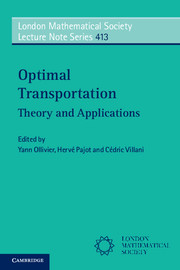Book contents
- Frontmatter
- Contents
- List of contributors
- Preface
- PART 1 SHORT COURSES
- PART 2 SURVEYS AND RESEARCH PAPERS
- 8 Computing a mass transport problem with a least-squares method
- 9 On the duality theory for the Monge–Kantorovich transport problem
- 10 Optimal coupling for mean field limits
- 11 Functional inequalities via Lyapunov conditions
- References
12 - Size of the medial axis and stability of Federer's curvature measures
from PART 2 - SURVEYS AND RESEARCH PAPERS
Published online by Cambridge University Press: 05 August 2014
- Frontmatter
- Contents
- List of contributors
- Preface
- PART 1 SHORT COURSES
- PART 2 SURVEYS AND RESEARCH PAPERS
- 8 Computing a mass transport problem with a least-squares method
- 9 On the duality theory for the Monge–Kantorovich transport problem
- 10 Optimal coupling for mean field limits
- 11 Functional inequalities via Lyapunov conditions
- References
Summary
Abstract
In this chapter, we study the (d — 1)-volume and the covering numbers of the medial axis of a compact subset of ℝd. In general, this volume is infinite; however, the (d — 1)-volume and covering numbers of a filtered medial axis (the μ-medial axis) that is at distance greater than ε from the compact set can be explicitly bounded. The behavior of the bound we obtain with respect to μ, ε and the covering numbers of K is optimal.
From this result we deduce that the projection function on a compact subset K of ℝd depends continuously on the compact set K, in the L1 sense. This implies in particular that Federer's curvature measures of a compact subset of ℝd with positive reach can be reliably estimated from a Hausdorff approximation of this subset, regardless of any regularity assumption on the approximating subset.
Introduction
We are interested in the following question: given a compact subset K of ℝd with positive reach, and a Hausdorff approximation P of this set, is it possible to approximate Federer's curvature measures of K (see [9] or Section 12.2.2 for a definition) from P only? A positive answer to this question has been given in [8] using convex analysis. In this chapter, we show that such a result can also be deduced from a careful study of the “size” – that is, the covering numbers – of the medial axis.
The notion of medial axis, also known as ambiguous locus in Riemannian geometry, has many applications in computer science. In image analysis and shape recognition, the skeleton of a shape is often used as an idealized version of the shape, which is known to have the same homotopy type as the original shape [14].
- Type
- Chapter
- Information
- Optimal TransportTheory and Applications, pp. 288 - 306Publisher: Cambridge University PressPrint publication year: 2014



